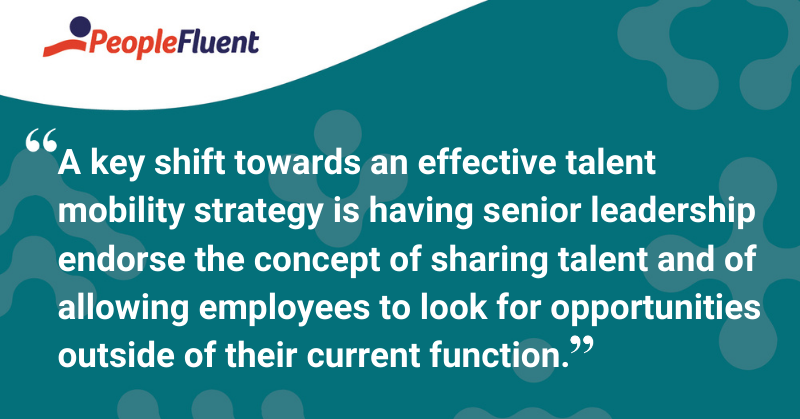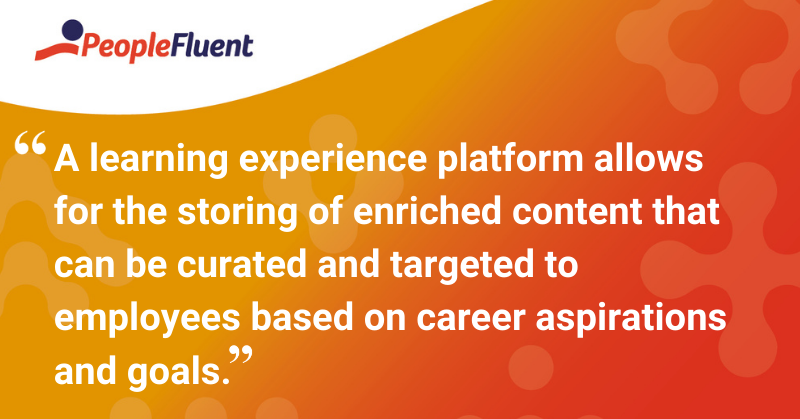Published: Jan 7, 2021Time to read: 7mins Category: Insights
Learning and Talent Mobility: A Winning Combination to Drive Employee Retention and Results
Table of Contents
PeopleFluent's Dawn Baron looks at how, by bringing together a talent mobility strategy with a learning experience platform (LXP), companies can offer a seamless employee experience while optimizing enterprise results.
Long gone are the days of hiring and retiring, but the debate as to whether to hire internally versus externally now skews heavily on the former. The world of work has changed just as drastically as every other area of our lives, making it a perfect time to focus on optimizing the value of what we have.
Organizations of all sizes are shifting to look inwards at their talent pool first, rather than looking externally to fill skills gaps and vacant roles. By providing employees with clear career development roadmaps and the right learning opportunities, organizations can build purpose-driven workplace cultures that engage, retain, and capitalize on top talent.
This is where combining a talent mobility platform and a learning platform can provide a seamless employee experience with clear benefits for the employer.
Related reading: ‘What Is Talent Mobility? Plus, What It’s Not!’
Reskilling, Upskilling and Mobilizing Employees in a Time of Constant Change
With many companies going into a hiring freeze in 2020, HR professionals have had to look internally to fill business gaps. Having to assess the type of talent, skills, and willingness of employees has been predominantly a manual task—one that has required resilience and resourcefulness from talent managers. It has also caused a shift to being more strategic about acquiring resources externally.
In doing so, organizations have realized that while there may be a willingness and interest from internal employees to do more outside of their normal scope of work, they may also require some level of skill development. With greater collaboration between HR and L&D teams, reskilling and upskilling initiatives become more strategic and effective. In one study, 51% of L&D pros planned to launch upskilling programs in 2020, with 43% planning to launch reskilling programs in the future. This is where the need for learning, and a learning platform that delivers timely recommendations and curated content, become an essential component to drive talent and business growth forward.
Today's employees are also taking greater ownership of their own careers and skill development. They have a vested interest in exploring what's available for them within and outside of their organization. With employee retention being a key factor in enterprise success, providing employees with both talent mobility opportunities and training keeps talent motivated and engaged in a time of constant change.
Companies need to identify high-potential employees and ensure they are getting the right level and intensity of work, as well as career progression and training opportunities. In fact, an average of 66% of employers surveyed in a World Economic Forum study expect to get a return on investment in upskilling and reskilling within one year. This represents an opportunity not to be missed.

You might also like: 'Everything You Wanted to Know About LXPs (But Were Too Afraid to Ask)'
Empowering L&D Teams and Professionals Through Technology
With the growing skills gap brought on by technology and the digitization of entire industries and processes, companies need to think about a sound and robust talent mobility strategy that properly showcases opportunities for employees.
A key shift towards an effective talent mobility strategy is having senior leadership endorse the concept of sharing talent and of allowing employees to look for opportunities outside of their current function.
There are two components that work hand in hand to facilitate this journey. They involve providing talent acquisition teams and employees with:
- A centralized talent mobility platform that gives employees and L&D teams visibility into needed or wanted learning content that can support career development initiatives.
- A modern learning platform that connects them with the right training to bridge knowledge gaps, or allows them to explore other roles within the organization through content
Why Using a Talent Mobility Platform Makes Sense
Here are three reasons why you should invest in a platform that promotes talent development and growth from within the organization.
- From a talent acquisition perspective, it provides a touchpoint for recruiters to start leveraging the tool immediately without having to use external engines to post opportunities, also incentivizing internal hires. This adds scalability to the employee recruitment and retention process by collecting data from every employee and providing them with the right opportunities at the right time.
- From an employee perspective, it engages and retains talent by keeping a record of their skills and aspirations. It also actively provides recommendations on possible career paths, as well as personalized content recommendations to bridge skills gaps towards career development.
- From an organizational cultural/mindset perspective, senior leadership teams can instill the use of processes and technology platforms and provide adequate training for managers around how to have effective career conversations with employees. This could include their next career move, developing new skills, and how to gain visibility of career progression opportunities within the company.

Handpicked for you: ‘3 Easy Ways Talent Mobility Can Increase the Effectiveness of Learning’
Top Benefits of a Modern Learning Platform as an Integrated Component of Talent Mobility Technology
Drive utilization of learning content: Integrated talent mobility and learning platforms (like an LXP) allow employees to see vacant roles within the company and the relevant skills they have for currently available positions. They also offer the ability to pull in related learning content that allows them to start developing the needed skills, so they can one day pursue another role within the organization.
Access to enriched and curated content: Engaged employees and mentors on a talent mobility platform can help L&D teams discover the type of content that's needed and deliver against that. A learning experience platform allows for the storing of enriched content that can be curated and targeted to employees based on career aspirations and goals. With both technologies on hand, employers can now easily identify gaps in their content based on employee interest in specific job roles, or deficiencies in certain areas of their current roles and quickly create or curate the learning content.
Efficiency and effectiveness: By integrating talent mobility and learning platforms, employees can explore career opportunities through content that is already available prior to committing to a new career path. This is a cost-effective and easy way for individuals to get exposure to new roles and topics through content that is free and already available on the platform. Similarly, companies can place employees in just the right places around the organization, getting the most out of their talent pool and saving on onboarding and training costs with employees that already understand and embrace the work culture and internal processes.

Conclusion
In summary, talent mobility technology allows for the democratization of interests and skills within an organization and matching employees to the right opportunities. In the best case, an organization's talent mobility strategy and technology link to a learning strategy and learning technology.
When L&D teams can find out through their talent mobility initiatives what their employees need, what they're lacking, or what they're very good at, this helps to inform the type of learning content that needs to be created and housed.
By authoring, curating, and promoting self-learning through the intersection of talent mobility and learning experience platforms, companies can offer a seamless employee experience that encourages growth and retention. This will increase company performance by mobilizing top talent in just the right places and at scale.
Keep reading: '5 Strategies to Improve Talent Mobility'